REPRODUCTIVE BIOLOGY OF A FLOWERING PLANT
The following web page represents a copy of my notes that formed the basis of lectures given during the first portion of the Biology of Plants (BOT 1103) lecture course. Please refer to your own notes, handouts, and to the textbook (Stern, K., R., J. E. Bidlack, and S. H. Jansky. 2008. Introductory Plant Biology, McGraw-Hill. 616 pp. - reading assignments are in the syllabus) for additional information. This web page does not include information found in various handouts and related materials (e.g., films, charts, overhead projections, etc.) that you will receive during the course of the semester. You will be evaluated over this information as well. If you note any errors in the following document, I'd appreciate it if you would bring this to my attention. Email address: mhuss@astate.edu.
Sexual Reproduction in Flowering Plants
Terms and concepts:
- ALTERNATION OF GENERATIONS
- For a diagram for parts of a flower (e.g., petals, sepals, androecium, gynoecium, etc.)
- Sporophyte- "spore-producing plant", which arises from a diploid (2N) zygote.
- Spore- are a result of sporogenesis (which includes meiosis). Spores germinate and develop into the haploid gametophyte.
- Gametophyte - "gamete-producing plant". Gametes are generated through cell division (mitosis + cytokinesis).
- Gametes - haploid sex cells (i.e., sperm or egg).
- Zygote- a consequence of fertilization of an egg by a sperm. Zygotes are diploid (2N).
- Pollination - transfer of pollen (i.e., the male gametophyte) to the stigma of a flower.
- Fertilization - the merging of the sperm nucleus with an egg to form a zygote.
Evolutionary trends from haploid to diploid dominance:
In lower plants, the sporophyte is dependent on the gametophyte for nutrition (e.g., mosses, liverworts). For higher plants this trend is reversed (e.g., conifers, flowering plants). The female gametophyte is dependent on the sporophyte for nutrition. The male gametophyte (i.e., pollen) is independent for a brief period, but requires sporophyte tissue (i.e., the stigma and style) in order to grow, release, and disseminate sperm nuclei to the egg found in the female gametophyte. The following discussion emphasizes the process as it occurs in flowering plants.
Reproduction in Flowering Plants
Refer to your
textbook (see assigned readings in syllabus), class notes, and to the links listed below and know the definition to terms discussed
in class (e.g., incomplete vs. complete flower, imperfect vs. perfect flower, zygomorphic vs. actinomorphic flower, superior ovary vs. an inferior ovary,
pistil and parts, stamens and parts, corolla, calyx, adroecium, gynoecium,
etc.).
|
|
|
If you are so inclined, you might consider visiting the web site for "Science Matters", which contains a 30 minute program on the Genetic Basis of Flowering (why some portions of the floral bud turn into sepals instead of stamens and so on). It is quite good. This program called Science Matters: The ABCs of Flower Development was shown in class on March 14th during the Biology of Plants lecture. The web address is: http://video.google.com/videoplay?docid=-3408394683405809314&q=flower. The original Web Site for this video is http://www.ucsd.tv/sciencematters/. I noticed that the program offers audio in English and Spanish, and subtitles in English or Spanish. If the lecturer starts speaking Spanish during the internet feed that you get and you don't happen to understand Spanish then click on the button that says “English audio.” This ought to transition it back to English in mid-sentence.
MEIOSIS AND SPOROGENESIS IN FLOWERING PLANTS
General Overview of Meiosis
1. Diploid cell (2n) containing 2 sets of chromosomes gives rise to haploid nuclei (1n) containing one set of chromosomes. Meiosis is a reduction division that occurs during the production of a spore ===> which gives rise to a haploid gametophyte (the gamete-producing plant) ===> which gives rise to the gamete (i.e., an egg or sperm).
2. Meiosis is divided into two parts: meiosis I (pairing of homologous chromosomes, crossing-over, and separation of homologues to separate cells); meiosis II (separation of non-identical sister chromatids into sister chromatids which go to separate poles of a dividing cell). In plants these haploid cells become the spore.
Terminology and figures for understanding meiosis
- homologous chromosomes - pairs of chromosomes similar in structure, morphology, centromere position and genes that they carry).
- synapsis - pairing of homologues during prophase I.
- bivalent - one of the pairs of homologous chromosomes which associate during the first prophase of meiosis.
- chiasmata - the points at which homologous chromosomes remain in contact as the chromatids move apart during the first prophase of meiosis. There may be up to eight chiasmata in a bivalent pair of chromosomes. chiasma (sing.)
- centromere = primary constriction - site of spindle fiber attachment during mitosis and meiosis.
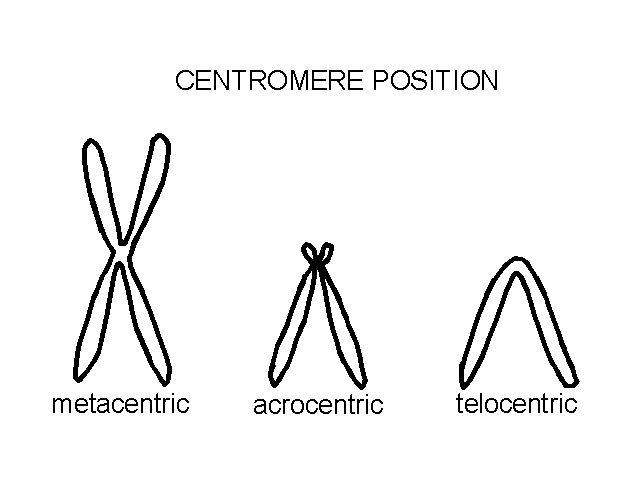
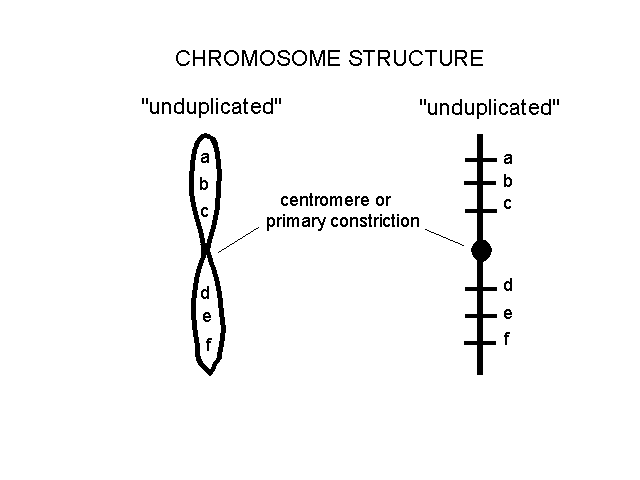
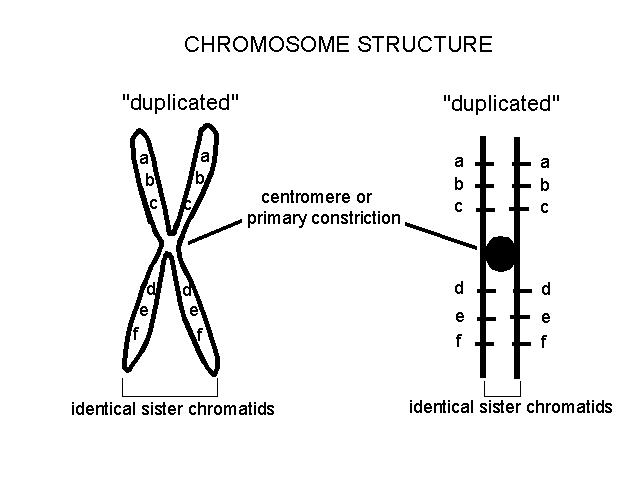
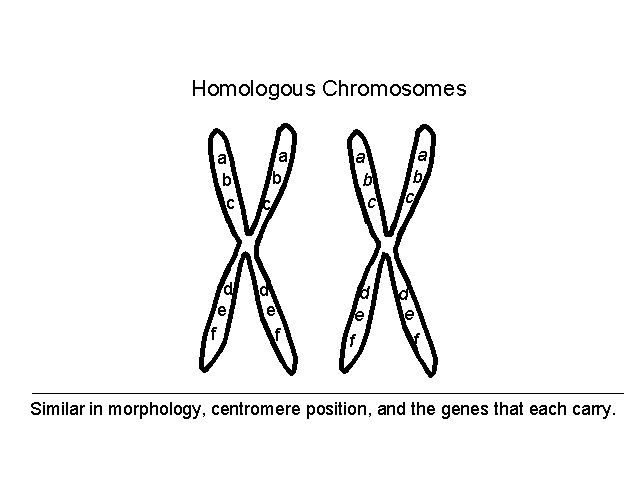
2 Divisions occur in Meiosis (Meiosis I and Meiosis II)
MEIOSIS I
- Prophase I
- Leptotene - chromatin condenses into individual chromosomes.
- Zygotene - pairing of homologues begins (synapsis).
- Pachytene - synapsis complete and chromosomes thicken and shorten.
- Diplotene - paired chromosomes begin to repel one another ==> chiasmata (points along paired homologues where both are still connected). This stage is associated with crossing-over!
- Diakinesis - maximum contraction, paired chromosomes, nuclear membrane and nuclei breakdown.
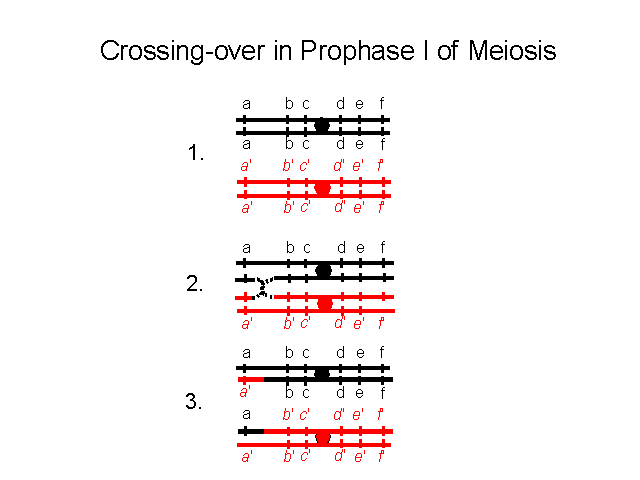
Genetic recombination through crossing-over.
- Metaphase I - chromosomes migrate to middle part of cell; spindle fibers attach to centromere. Process is random- INDEPENDENT ASSORTMENT.
- Anaphase I - Homologues separate and move to opposite poles
- Telophase I - two haploid sets of chromosomes now exist, each set at the opposite pole of cell.
- Prophase II - chromosomes condense.
- Metaphase II - chromosomes move to middle part of cell.
- Anaphase II - separation of non-identical sister chromatids into sister chromosomes.
- Telophase II - nuclei reform and you are left with 4 haploid spores.
- For some great animations demonstrating the major events of meiosis visit: http://highered.mcgraw-hill.com/sites/0072437316/student_view0/chapter12/animations.html
MICROSPOROGENESIS - Diploid cell = microspore mother cell ==> meiosis ==> 4 spores at the end of process (i.e., tetrad). Each microspore becomes the pollen grain = male gametophyte.
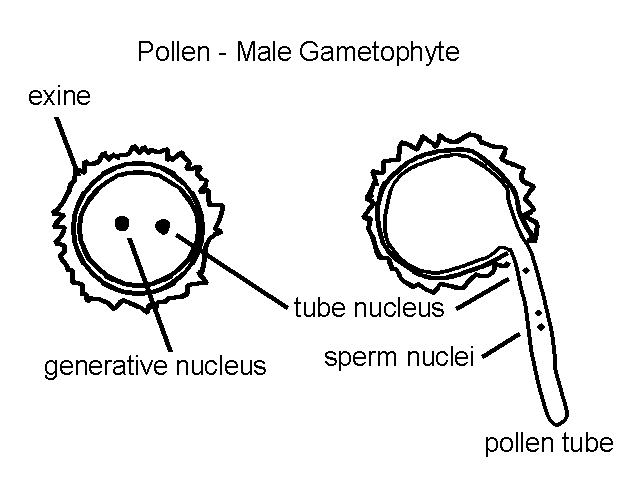
MEGASPOROGENESIS - Diploid cell = megaspore mother cell ===> meiosis ===> 4 haploid megaspores ===> 3 degenerate leaving one big megaspore. Embryo sac = female gametophyte. Embryo sac + integuments (protective coverings, which develop into the seed coat) = ovule.
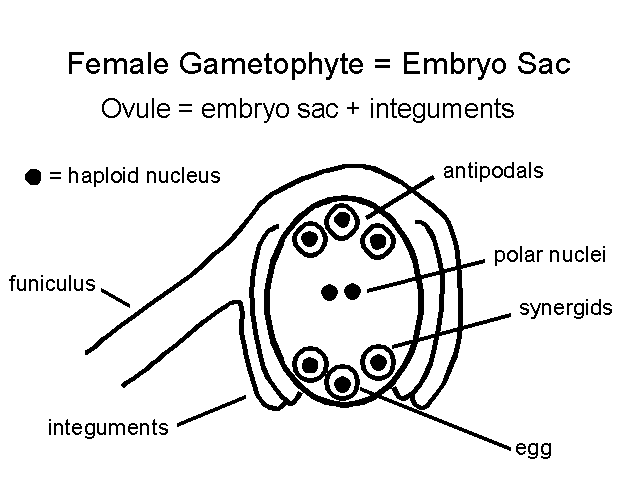
Pollination (i.e., deposition of pollen on the stigma of the pistil) may lead to pollen germination and eventual delivery of sperm nuclei to the embryo sac via a pollen tube. The pollen tube grows through the style of the pistil until it reaches the entrance of the embryo sac in the ovary.
POLLINATION AND FERTILIZATION ARE NOT EQUIVALENT TERMS
Pollination may be accomplished a
number of ways, but in flowering plants it usually involves dispersal by
wind or by a pollinator (e.g., bird, mammal, insect, lizard, etc.).
In the male
gametophyte,
the production of sperm nuclei and in the female gametophyte, the production
of an egg and polar nuclei are a consequence of mitotic (not meiotic) division.
Hence gametogenesis
is a result of mitosis occurring within the body of the pollen grain (male
gametophte) and the embryo sac (the female gametophyte).
Double fertilization as it occurs in most flowering plants (about 70 %) Polygonum-type:
- Polar nuclei + sperm nucleus = 1N + 1N + 1N = 3N (triploid endosperm; nutritive tissue for the embryo).
- Egg + sperm nucleus = 1N + 1N = 2N (diploid zygote) ==> The zygote becomes the embryo which gives rise to the sporophyte (i.e., the plant that produces the spores).
In lilies (process is atypical): megasporogenesis ==> all four megaspores form the embryo sac. Consequently during double fertilization the following happens:
- Polar nuclei + sperm = 3N polar nucleus + 1N polar nucleus + 1N sperm nucleus = 5N endosperm.
- Haploid egg + haploid sperm nucleus = diploid embryo.
Also review the following two PowerPoint Presentations given in class during lecture
Fruits types and seeds
- Carpels are ovule-bearing leaves. Carpels or pistils may be simple or compound. As the ovules develop into seeds, the wall of the ovary of the carpel or pistil ripens.
- A fruit in an angiosperm or flowering plant is the ripened ovary wall that encloses the seed. The ripened ovary is called the pericarp which is divided into three layers (endocarp, mesocarp, and the exocarp).
- Know some common examples of plants with different fleshy and dry fruit types: Berry, drupe, pepo, hesperidium, pome, capsule, silique, follicle, legume, caryopsis, samara, nut, achene, aggregate fruit, and multiple fruit.
- Visit the following web site at http://waynesword.palomar.edu/plapr98.htm and learn how "burs" (a achene covered in hooks) lead the way to the Velcro®.
- Visit the following web site to learn more about pomes and other fleshy fruits at http://waynesword.palomar.edu/ecoph17.htm.
- Refer to the textbook regarding the anatomy of a seed.
- Refer to the textbook regarding seed germination and seedling development.
VISIT http://botit.botany.wisc.edu/images/130/ FOR IMAGES OF PLANT CELLS AND TISSUES: CLICK ONTO LINKS LISTED AS ANGIOSPERM, MEIOSIS, FRUIT, AND EARLY DEVELOPMENT.
This web page was assembled by Dr. Martin J. Huss - Last modified on October 11, 2007.